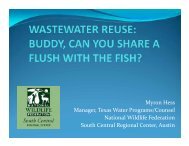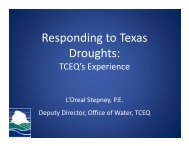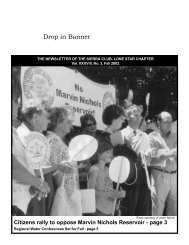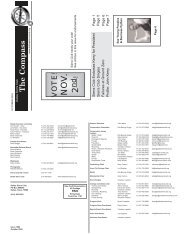comments in PDF - Lone Star Chapter, Sierra Club
comments in PDF - Lone Star Chapter, Sierra Club
comments in PDF - Lone Star Chapter, Sierra Club
You also want an ePaper? Increase the reach of your titles
YUMPU automatically turns print PDFs into web optimized ePapers that Google loves.
GMP/EIS so that public and decision-makers can review, comment on, and understand<br />
what NPS proposes to do about these impact topics.<br />
22) Pages 51-52, Water Quality and Quantity (Surface and Groundwater), the <strong>Sierra</strong><br />
<strong>Club</strong> disagrees that this impact topic should not be completely analyzed, assessed, and<br />
evaluated <strong>in</strong> all alternatives of the draft GMP/EIS. Water is the lifeblood of the desert<br />
and high mounta<strong>in</strong> areas. The way that NPS wants to protect water quality and quantity<br />
should be <strong>in</strong> all alternatives of the draft GMP/EIS. What does “would substantially<br />
change” mean The public and decision-makers need this <strong>in</strong>formation so they can<br />
review, comment on, and understand the Preferred Alternative.<br />
23) Page 52, Wilderness Resources and Values, the <strong>Sierra</strong> <strong>Club</strong> disagrees that this<br />
impact topic should not be completely analyzed, assessed, and evaluated <strong>in</strong> all<br />
alternatives of the draft GMP/EIS. This is particularly true s<strong>in</strong>ce GMNP is a Wilderness<br />
national park.<br />
The <strong>Sierra</strong> <strong>Club</strong> does not support additional use of dynamite to make trails and does not<br />
believe that NPS should focus on “improve safe access to wilderness areas”. NPS<br />
should focus on protect<strong>in</strong>g Wilderness character. Wilderness character should not be<br />
degraded to make Wilderness safe for visitors. This is what the Wilderness Act<br />
requires.<br />
Wilderness is where people enter at their own risk and bow to the risks that Wilderness<br />
poses, on Wilderness’ terms. It is a place where humans leave their arrogance at the<br />
Wilderness boundary and enter with humility and not with the typical control and<br />
manipulation (trammel<strong>in</strong>g) that we do <strong>in</strong> our human modified and built environment.<br />
NPS should not be <strong>in</strong> the bus<strong>in</strong>ess of de-wild<strong>in</strong>g and de-fang<strong>in</strong>g Wilderness.<br />
More trails are not needed <strong>in</strong> designated Wilderness <strong>in</strong> GMNP. NPS calls build<strong>in</strong>g new<br />
trails <strong>in</strong> GMNP “long-term beneficial impacts” but the Wilderness Act says that<br />
<strong>in</strong>stallations and structures are not allowed. Build<strong>in</strong>g new trails would result <strong>in</strong> reduced<br />
Wilderness character which is a long-term negative impact and these actions are not<br />
beneficial to Wilderness protection and the protection of Wilderness character. The way<br />
that NPS will protect Wilderness character should be <strong>in</strong> all alternatives of the draft<br />
GMP/EIS so that public and decision-makers can review, comment on, and understand<br />
what NPS proposes to do about these impact topics.<br />
<strong>Chapter</strong> 2: Alternatives, Includ<strong>in</strong>g the Preferred Alternative<br />
24) Page 56, Visitor Use Capacity, the NPS states “Rather, user capacity is measured<br />
by compar<strong>in</strong>g desired resource and visitor experience conditions to actual conditions<br />
and, when an imbalance is noted, employ<strong>in</strong>g management practices to return to the<br />
desired conditions.” This may be true <strong>in</strong> <strong>in</strong>stances but for some resources there is no<br />
return<strong>in</strong>g to the “desired conditions”. For <strong>in</strong>stance, soil erosion and cryptogrammic crust<br />
damage is <strong>in</strong> essence forever because the process of creat<strong>in</strong>g soil and cryptogrammic<br />
crusts, especially <strong>in</strong> desert and or mounta<strong>in</strong> habitats, is extremely slow. The loss of 200<br />
9







